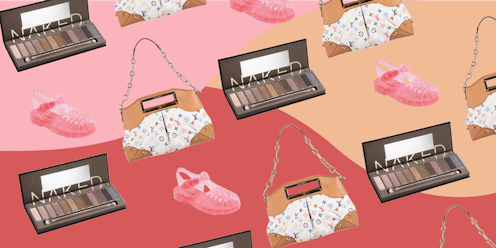Style
There's Privilege In Relating To Nostalgia & It's Time To Start Talking About It

Ah, nostalgia. Any ‘90s kid knows the feeling well, having spent countless hours wishing for the return of boy bands, hair crimpers, and jelly shoes. And while some forms of nostalgia hit the majority of us in the collective feels, there’s a hidden component to nostalgia that is often ignored. That is, relating to certain types of nostalgia — especially those it the fashion and beauty realm — often requires a certain amount of economic privilege. Access to trendy items that become tomorrow’s wistful style memories doesn’t come for free, often requiring that the person had disposable income for items beyond basics in that particular decade. And that means some mainstream nostalgia has an accessibility problem, especially for people from low income backgrounds.
Media coverage of and general discussions around nostalgia is dependent on people experiencing the same thing in a similar way. In fact, nostalgia often assumes all people have a certain experiences tied to a certain decade. The danger in that, especially when it comes to pricey items in fashion and beauty, is that this assumed universality can alienate and erase the experiences of low income people.
Though nostalgia can bring some of us together through collective memory, it can also divide us. And it's time to talk about that.
When we talk about nostalgic things, like the multicolored Louis Vuitton bag Kylie Jenner recently resurrected or the just discontinued original Urban Decay Naked palette, we often assume everyone had access to these things. In fact, we often preface conversations about nostalgia with, “Remember when everyone had…” or a similar phrase that assumes universality.
Those who grew up in the upper and middle class can and do glaze over this language because, in their communities, everyone did have access to these items. But for those who grew up in the working class or in poverty, this conversation around nostalgia can feel alienating. After all, low income kids often don’t have access to the latest trends that will become the pillars of nostalgia as they grow into adulthood.
Of course, there are aspects of childhood nostalgia of which the majority can relate, especially those not dependent on money. Whether you were waving your hair with a $100 hair crimper or tiny (free) braids that you slept on all night, crimping was accessible to the masses in the ‘90s. And every store from pricey Limited Too to inexpensive WalMart was selling jelly shoes in 1996. Trends like these, which had wide-reaching accessibility, can make most of us feel a similar way.
But other trends are more elusive, even if it’s just in how we remember certain items. While some people remember Bath & Body Works Cucumber Melon Lotion as the inexpensive lotion everyone had, others may remember the tiny one ounce bottle they got during the holidays and cherished. While some people remember wearing their heart-shaped Tiffany bracelet every day to high school, others can’t even fathom touching a Tiffany’s bracelet.
When Urban Decay recently announced the discontinuation of their iconic Naked palette, the dominant narrative on social media was one of nostalgia. Specifically, many upper and middle class millennial women recalled the original Naked palette as their first foray into the world of cosmetics. And while that was a way in which some women experienced the neutral eyeshadow palette, women who grew up low income were left out of that makeup memory — including myself.
I bought my first Naked palette at 24 years old after years of struggling to make ends meet as a woman paying her own way through early adulthood. The shadow set wasn’t a even full Naked palette; it was a mini collection with six select shades. When I purchased it, I got emotional at the memory browsing Sephora as a teen, thinking the pricey products there weren’t for girls like me. I would look wistfully at the original Naked palette and remember when the $27 price tag felt completely out of reach. Buying any Naked palette was a marker of success for me. It meant that I was doing better than my teenage self could have ever dreamed.
This was what a simple eyeshadow palette represented to me. This was my nostalgia. But it wasn’t the dominant narrative, rather an overlooked story buried under the privilege that can define nostalgia.
Nostalgia can’t always be universal, but that doesn’t mean we can’t still enjoy it — and learn from it. When we look back at the items that were once coveted in past decades, it's important to recognize the way we experienced those things isn't necessarily universal. When we are reminded of that, we start to uncover untold stories of inequality and struggle in our past. These are the buried stories that a single story of nostalgia can deny us.
The young girl sleeping on thin braids before picture day who had perpetually sweaty feet from WalMart-brand jelly shoes — that girl was me. And that girl wants you to have your joyful nostalgia. She just doesn't want to be erased by it.